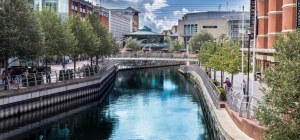Developers should look to the regions for growth
This article was first published by Property Week.
Rising demand has opened up many development opportunities for investors beyond London.
London is running out of space to live and work. City buildings are getting taller, residential land is becoming more expensive and the sites available for developers are getting smaller.
With desperation to reclaim land in the city, developers and landlords have used transport infrastructure as a springboard to property development and have built around and above overground and underground stations like St Pancras and Paddington. TFL have even taken on a housing target. The Government has promoted residential development on top of existing buildings as an attempt to solve the housing crisis but space is running out.
And yet, demand to be close to the capital continues to grow.
With increased transport links, new opportunities have arisen on the outskirts of London’s hustle and bustle as investors have begun to put faith – and money – into development beyond the capital and into the regions.
In other words, while London remains a globally important business and financial centre, developers are beginning to look further afield. The result is the rise of developments in places like Reading, Cambridge and Southampton which are all locations where BDB Pitmans LLP have offices.
All three are established destinations in their own right, but they are also attractive as alternative hubs for London. For developers, for businesses and for residents, it’s a chance to reap all of the benefits of connectivity to the capital without the headaches of lack of space and astronomical rents.
Take Reading, for example. The town centre has a population of less than 200,000 and is situated in the heart of leafy Berkshire roughly 40 miles from London. Here, there is a different pace and quality of life than in Zone 1.
Despite seeming so far removed from London, it’s in fact a mere 25 minute train journey to Paddington. As such, it’s a town where commercial development is booming. Serviced office space, once something reserved just for London’s quirkiest neighbourhoods, is now in high-demand in Reading.
In Cambridge, proximity to London at a fraction of the price has also lead to a boom in investment in both commercial office space and residential redevelopment. The likes of Apple, Microsoft, Amazon and Astra Zeneca have invested in commercial space there and its reputation as the UK’s answer to Silicon Valley continues to grow.
Admittedly the technology-driven area known as the Oxford-Cambridge-Arc has not quite yet earned the title of the UK’s Silicon Valley, though it’s a region with ambitions to attract and retain entrepreneurial talent and investment and it does have a lot going for it. Cambridge hosts one of the world’s oldest and most well-renowned universities which supports some of the most modern and advanced research and development opportunities.
Faced with increasing property prices in London – many tech start-ups are looking to the Oxford-Cambridge-Arc as an opportunity to set up next to liked-minded businesses and attract people who are looking for interesting careers with a good quality of life. Long term landholders such as the University Colleges are now accepting their need to play a role and look at development opportunities within their portfolio.
Finally, there’s Southampton. Another viable investment location, the famous port city has great opportunities for import and export business, as well as two universities and an airport. For businesses who want cheaper space, access to trade and good transport links to London, it’s a compelling location.
But there are challenges. To unlock all of the potential in these regional cities, the Government needs to continue to invest money and resources into these regions as well as free up the red tape surrounding the UK planning regime.
As an example, we need to see more mixed-use developments in the urban centres of these three places. Rather than purely focusing on one use class, we need to see a combination of residential, office, retail and leisure all in one spot.
Gone are the days of isolated out-of-town business parks that offer nothing but parking spaces and bland offices. Developers want to be more dynamic in this regard. We’ve seen high-quality restaurants, leisure spaces and even bee-keeping courses in green spaces within business parks as they have become live-work communities.
The Government needs to incentivise this kind of dynamism, but it also needs to make sure that it can achieve that while keeping these communities as places where people can enjoy a significantly more affordable standard of living than they can in London.
Striking that balance is a tall order, but it’s not an impossibility. By allowing developers to build more to meet demand, we can keep these places affordable. A more considered approach to business rates would also be welcome if we are to encourage rather than smother a vibrant high street offering.
Finally, we need to see better transport links. Reading enjoys short travel time to London which will only improve with Crossrail, and there’s still a lot more that can be done. Connecting up the Oxford-Cambridge-Arc with improved rail and bus networks is a good start, but we need to see more and we need to see it come to fruition sooner.
It’s important to remember that all of this excitement around these regions has happened in spite of Brexit, and that excitement needs to be nurtured.
After all, though Brexit will undoubtedly continue to have a big impact on the economy, we should not underplay the impact that HS2 and Crossrail will have when they eventually open. HS2 will mean a fast connection to London from Leeds, Sheffield, Nottingham, Manchester, Liverpool and Birmingham with the opportunity for yet more investment across the North and South… Growth around the capital will also be facilitated by Crossrail which will stretch for more than 60 miles from Reading and Heathrow to the west of the capital, through tunnels and across to Shenfield and Abbey Wood in the east.
Attitudes are changing. A 30% increase in demand for flexible office space across the UK shows that new businesses don’t want to do things the same way we’ve been doing them for the last few decades. London is still a vital financial centre for the country, but more and more businesses are realising that a showcase HQ in London isn’t the necessity it once was.
As London becomes more expensive, we will see more start-ups taking an interest in regional hubs and in the options that business park communities and flexible offices can provide. What we’re seeing is a lifestyle change as well as business change as people latch onto the idea that they can live and work somewhere cheaper without having to accept mundanity as a natural consequence.
All of this doesn’t spell the end for London. If anything, it strengthens the capital while enlivening regional opportunities. London is great, but there are many businesses that can get by on a travel-card rather than a season ticket.









